Cold Atom Quantum Simulation

Speaker(s): David Weld
Ultracold neutral atoms trapped in optical lattices represent a new frontier for the investigation of outstanding problems in many-body quantum mechanics. These systems promise to bring the precision and control of atomic physics to bear on important problems in condensed matter physics, from nonequilibrium spin dynamics to d-wave superconductivity. The ambit of this fast-growing field is expanding from measurement to control, and from statics to dynamics. Breakthroughs in the ability to exert full spatiotemporal control over the evolution of cold atomic gases will enable a new generation of experiments at the boundary between condensed matter and atomic physics.At UCSB we are building two experimental platforms (based around ultracold lithium and strontium) which will enable the creation and study of new, highly tunable, and strongly correlated phases of matter. Experimental goals of the lithium platform include quantum simulation of condensed matter Hamiltonians, the demonstration of effective time-reversal in a lattice-trapped gas, and the study of dynamical pseudospin ordering in higher-dimensional tilted lattices. The rich electronic structure of strontium may enable the creation of chiral spin liquids and states exhibiting SU(10) magnetism, and the ultra-narrow intercombination transition along with the negligible scattering length of the heaviest stable strontium isotope are particularly appealing for quantum sensing experiments.